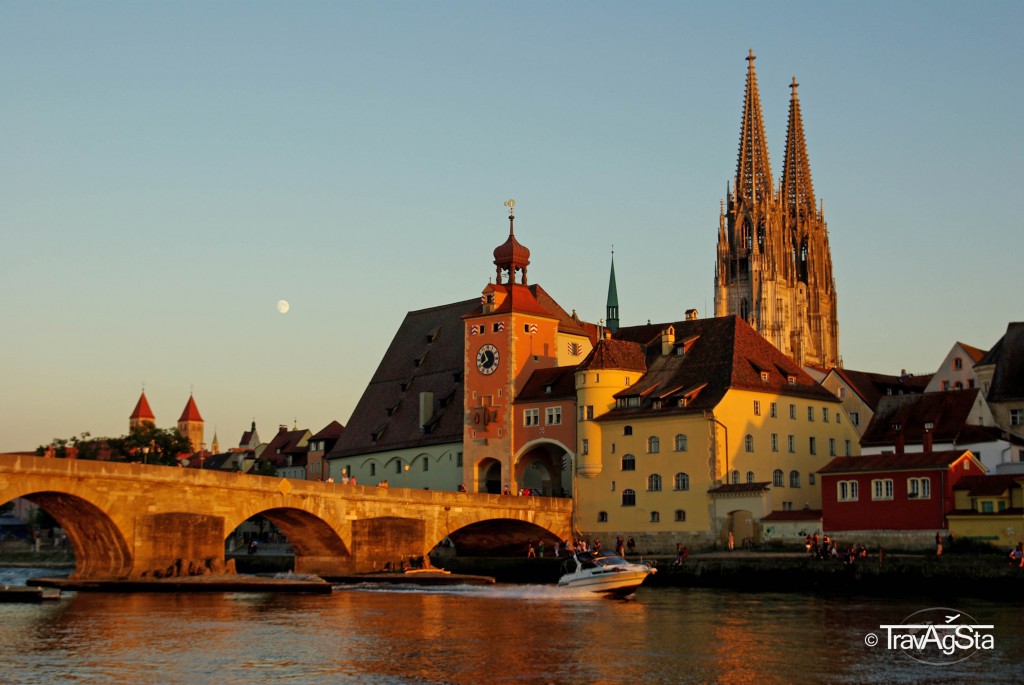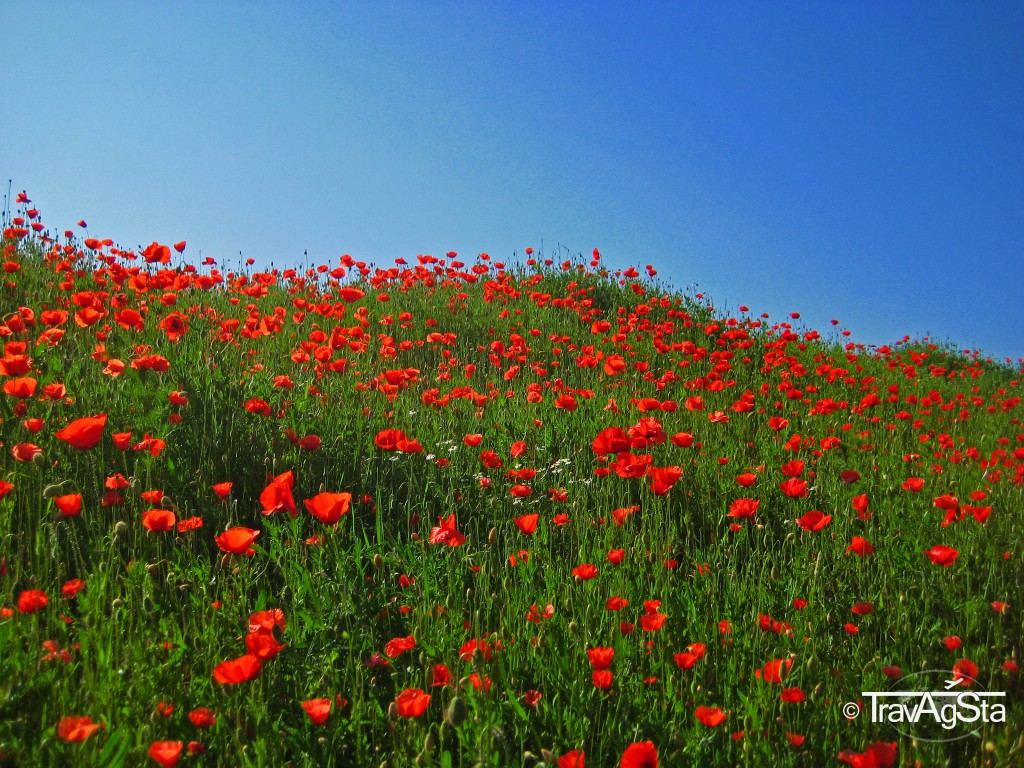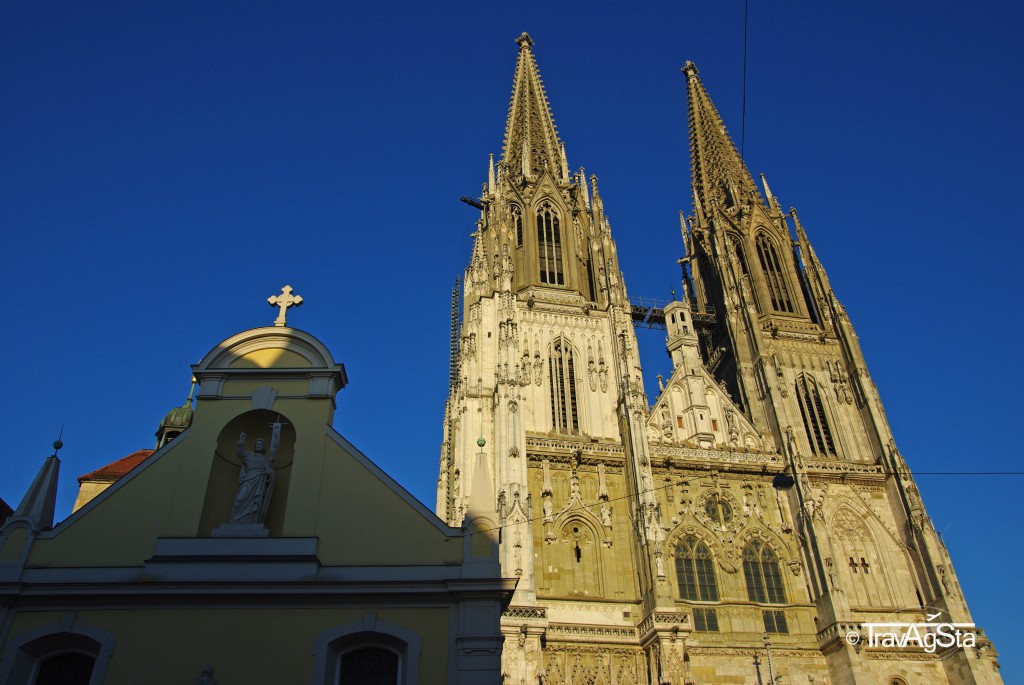Writing a sightseeing post about your hometown is not that easy. Especially, when you realize what you haven’t noticed for years and ignored the historic value.
Obviously, life goes on, after all. At home, we ignore successfully, what seems to be understood everywhere else.
The touristic view for our hometown developed subtle – in fact quite fast, when we moved to Frankfurt.
So what can you see in our hometown? Why was the whole Old Town declared as UNESCO World Heritage and what makes the inhabitants walk around like proud peacocks?
Regensburg’s Cathedral
Due to its spires being over 100 meters high, you can see the St. Peters cathedral from far away. You can read all the historic facts on Wikipedia or the tourism homepage of Regensburg.
What’s good to know: By day, it’s very photogenic. The steps of the cathedral are perfect to rest a while and observe the natives! At night, it is beautifully illuminated and still photogenic. At weekends though, it might smell a little bit like urine, as Party folks forget their manners.
Steinerne Brücke/ The Stone Bridge
The Stone Bridge in Regensburg is Germany’s best preserved bridge from the middle ages. Together with the cathedral, it’s the towns landmarkl. The bridge connects the Old Town with Stadtamhof; it’s 336 meters long and was finished in 1146. At the moment, it’s being restored but you can still walk over it.
Next to the bridge, there is the Historical Wurschtkuchl. It’s the oldest sausage grill worldwide and for 850 years in family property. They’re selling the typical Bratwurst since the 19th century.
The Salzstadel is also located next to the bridge. Salzstadel is the German expression for a place, where salt was stored. It was built in the 17th century and like many other buildings in Regensburg, it’s landmarked.
The Old Town of Regensburg
Regensburg and the Middle Ages – thanks to the Patrician Towers, they still belong together somehow. The Family Towers should symbolize wealth and power.
The families took Italy as an example, which tradesmen used to visit a lot. One of the biggest are the Haus Heuport at the cathedral and the Goldenes Kreuz at Haidplatz.
The alleys of the city are a dream for itself. There is nothing more to say about them.
The Porta Praetoria is a gate from Roman times. Together with the Porta Nigra in Trier, they’re the only Roman gate complexes north of the Alps being preserved.
The Dani-Karavan-Memorial at Neupfarrplatz was designed by an israeli artist of the same name. It was built where the former Jewish Quarter was.
Stadtamhof
Stadtamhof was once an own city and became part of Regensburg in 1924.
Unfortunately, we don’t have any pictures of Stadtamhof. But we will add those in the future. This is what I said in the beginning: We have pictures from so many parts of the world, but not of our hometown.
Regensburg and it’s Piazzas
The Neupfarrplatz is located in the center of the Old Town, not far from the cathedral. After the destruction of the Jewish Quarter, a pilgrimage church was built here. Not until in the middle of the 19th century, people started to use the huge square as a business quarter or for events.
During an excavation from 1995 to 1998, archaeologists found huge parts of the medieval basement construction of the former Jewish Quarter at the Neupfarrplatz. You can visit the area with a guide and only on certain days.
You can get more information on the city’s homepage.
At the Kohlenmarkt there is nothing special. The statue of Don Juan d’ Austria stands here. It’s a nice place for having a coffee or other drinks. Between Kohlenmarkt and the Cathedral, you can find the Goliath House, a former patrician castle.
The Old Town Hall is located between Kohlenmarkt and Haidplatz. Between 1663-1803, the Perpetual Diet of Regensburg (also called Eternal Diet of Regensburg – some kind of European Parliament these days) was based here. It was a permanent diet of the Holy Roman Empire.
Knight’s tournaments took place at Haidplatz in the Middle Ages. Today, the patrician tower Goldenes Kreuz still stands here. Today you can find loads of restaurants. From spring on, depending on the weather, you can sit outside.
The Bismarckplatz: The city theatre and a former French President’s Palais are located here. Two fountains, two cafés and two bars. In beautiful summer evenings, people gather here and have a drink or two (or three). It feels like being on an Italian Piazza.
Not far from here you can find the Scots Monastery St. James built in the 12th century by Irish missionaries. The most interesting about this church is its north portal with its mysterious sculptures, no one knows the meaning of them. Unfortunately, we have no picture of the Scots Monastery, but we’ll add it as soon as we can.
Thurn and Taxis Castle and Saint Emmeram’s Monastery
Regensburg’s glamour family is living here. The annoying Gloria of Thurn and Taxis might sound familiar to you. The pomp rooms are worth a visit.
Regensburg from the above
From the top of the Dreieinigkeitskirche (Trinity Church) at the Gesandtenstraße you can enjoy the best view over the roofs of Regensburg’s Old Town. Especially at sunset.
Furthermore: From the rooftop of the Galeria Kaufhof you have an amazing view at the Neupfarrplatz and the Cathedral.
And: A bit far from the Old Town, but the bus ride up to Ziegetsberg to the television tower is worth it. You’ll have an great view over the city from up there.
A little bit outside
While you can reach everything easily in the Old Town, some important sights are in Regensburg’s surroundings. I suppose, if tourists and travellers get lost somehow there, they might not return as it is just a small town. Just because of that, you shouldn’t miss the following.
Walhalla
We’re a little bit ashamed of that picture. One of the most important sights in Germany, but we only have a handful of not so professional pictures of it.
Bavarian King Ludwig I ordered to build the Hall of Honours in 1842. As said before, it is one of the most important buildings in Germany. Ludwig’s aim was the presentation of Germany’s most important people on memorial tablets and marmoreal busts. It was intentionally built after the Parthenon in Athens. The name Walhalla derives from Germanic mythology.
Hundertwasser Abensberg
Like in Vienna or Darmstadt or New Zealand, the small town (actually it’s only a village, if you ask me) near Regensburg has its own Hundertwasser building. It’s also called Kuchlbauer’s Tower, as it is the Kuchlbauer Brewery’s landmark.
It’s also called the “Lighthouse of Bavarian beer”. It’s 35 meters high and open to public since 2010.
Donaudurchbruch and Weltenburg Monastery
The Donaudurchbruch is a nature-sanctuary. Officially, it’s also called Weltenburger Enge. If you want, you can make a boat tour and experience the Danube flowing through a very narrow channel. On both sides, there are high rocks and cliffs.
In the north east of the Donaudurchbruch, you can visit the Befreiungshalle.
The Benedictine abbey of Weltenburg in Kelheim is Bavaria’s oldest monastery. It’s supposed to be founded in 620 AD by Irish-Scottish monks.
The beer garden is awesome. Maybe you should avoid visiting this place on sunny public holidays, if you don’t want it to crowded.
Regensburg is one of the oldest cities in Germany. It will be your own fault, if you don’t spend at least a few days here!
By the way, this post is not sponsored. We made it out of pure love!


